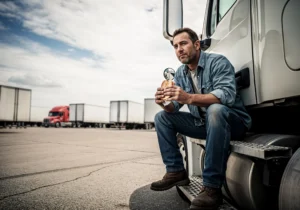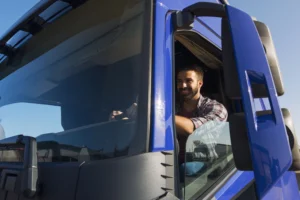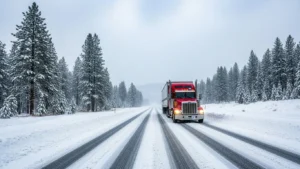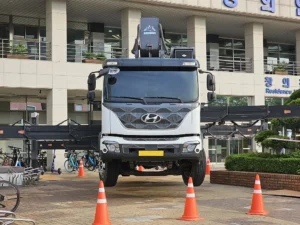These haulers are responsible for transporting NASCAR cars, serving as repair workshops, meeting rooms, observation decks, and more.
NASCAR races, established in 1948, have become one of the most popular sports in the United States and other parts of the world. With around 1,200 events in countries like the United States, Canada, Mexico, and Europe, NASCAR is an icon for fans of high-performance vehicles.
Over the years, in addition to race cars, another type of vehicle has gained prominence: the haulers responsible for transporting NASCAR cars. Since the races are not held on conventional roads and are spread across the U.S., these haulers play a crucial role in moving the cars from one track to another between events. However, their function is not limited to transportation; they also serve as repair workshops, restaurants, meeting rooms, observation decks, and storage spaces.

History of NASCAR haulers
Although today NASCAR cars are transported in this way, it wasn’t always the case. The idea of using haulers didn’t emerge until the 1990s, after several attempts and inventions to move the vehicles. In the beginning, NASCAR race cars were regular vehicles with numbers painted on the sides, and the drivers themselves would transport them from track to track.
As NASCAR races became more popular and spread across the country, transporting the cars from one circuit to another became a problem. On one hand, long trips added wear to the engines, and on the other, the long distances caused damage to the vehicles, affecting their performance. In response to this, a solution was needed, and that’s when haulers were introduced to transport the cars, though not in the way we know them today.
The initial idea for transporting NASCAR cars was to hook a flatbed trailer to a pickup truck. Later, the box truck with a trailer was introduced, used by teams like Petty Enterprises. These innovative trucks included fans, radios, and beds for the driver, which helped reduce lodging costs. Additionally, the truck’s box stored spare parts, tools, and supplies for the pits.
Richard Petty and his company were pioneers in these improvements, with the idea that reducing the use of cars on the road would extend their lifespan on the track. These innovations marked the beginning of the evolution of NASCAR haulers, which would continue to transform thanks to other major innovators like Bud Moore.

The rise of NASCAR haulers
Bud Moore, a member of the NASCAR Hall of Fame, was a pioneer in creating enclosed trailers for transporting NASCAR cars. In 1982, he debuted an enclosed trailer that protected the vehicles from damage and contained everything needed for a race weekend, including spare parts and a backup car. This innovation was quickly adopted by other teams, leading to the expansion and improvement of NASCAR haulers.
In 1991, Richard Childress, with his GM Goodwrench No. 3 team and Dale Earnhardt, took the idea even further by creating a “garage on wheels.” He collaborated with Featherlite Trailers to design a two-story trailer that not only transported cars but also carried parts, engines, and featured a command center, diagnostic area, and observation platform. This design set the standard for modern NASCAR haulers, which continues to be used today.

NASCAR haulers today: features and parades
Today, the foundations established by Childress and his team remain, with some modifications made by each team to meet their specific needs. A NASCAR hauler typically includes the following:
- Sleeping cabin: The front cabin is equipped with a space for drivers to rest during trips.
- Fully equipped office: At the front of the hauler is a communications office where strategies are analyzed and contact with drivers is maintained.
- Generator: Each truck has its own generator to provide enough power for all the technological equipment.
- Car bay: The hauler includes a space designed to house two cars: the primary car and the backup.
- Mechanical garage: An area of the hauler is designated to store tools and spare parts for repairing potential car damage.
- Upper platform: The haulers are equipped with a platform from which the race can be observed.
If you’re wondering how all of this fits, these haulers can measure up to 24 meters (80 feet) long and weigh up to 86 tons. Additionally, like the cars, they are decorated with logos, numbers, and bright colors, making the haulers parades a unique experience for NASCAR fans.

The tradition of haulers parades has become so popular that many tracks now broadcast them live, as well as the parking of haulers inside the track. The teams arrive at the track at the same time and drive through the streets toward the facilities, offering a one-of-a-kind show for the spectators.

Truck drivers are at high risk of developing diabetes
About 11% of the adult population meets the criteria for prediabetes, and there is a particular group at high risk: truck drivers. Diabetes rates in

Starting in trucking: required permits, registrations, and compliance
Are you a new carrier? This is what you need to know about permits, registration, and compliance. The trucking industry can be quite challenging for

Alberta Clipper Brings an Early Polar Blast: A Critical Alert for Drivers
The Alberta Clipper is sweeping across the country with fast-moving Arctic air, sharp temperature drops, and dangerous road conditions that demand heightened attention from all professional drivers.

American manufacturers trigger truck “dumping” investigation
Foreign trailer manufacturers under investigation for alleged “dumping” in the U.S. The U.S. truck market is at the center of a trade dispute. After domestic

ATRI Warns: Litigation Is Rising Across the U.S. Trucking Industry
A new report from the American Transportation Research Institute (ATRI) reveals how escalating litigation, higher legal costs, and mounting insurance pressures are reshaping the U.S. trucking industry. The findings mark a critical moment for motor carriers, insurers, and logistics stakeholders who must understand the changing legal environment — and the increasingly strategic role of strong insurance partnerships.

FMCSA says no to hours-of-service exemptions
FMCSA rejects two requests for exemptions to hours-of-service rules for commercial drivers. The Federal Motor Carrier Safety Administration (FMCSA) has denied two exemption requests related
